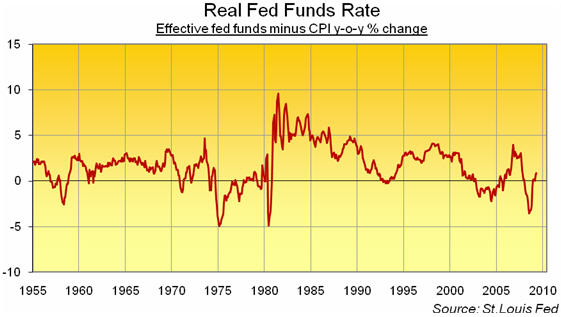Pick a Number...Any Number
Explained: Why the US Fed needs to destroy the Dollar, economy and savers...
"We are entering upon waters for which I have no chart and in which I therefore feel myself an utterly incompetent pilot."
– James Warburg of the banking dynasty, resigning as President Roosevelt's monetary advisor, 1933
WANT TO KNOW WHERE the price of gold, oil, the S&P, Euro or overseas stock markets are heading?
Pick a number, any number. Go on, choose whatever number you like! Because that's how policy-makers and their advisors would like to set the common denominator of asset prices – the value of money.
"When I calibrate my favorite version of the Taylor rule using the most recent data," says Greg Mankiw, professor of economics at Harvard and chairman of Dubya Bush's council of economic advisors, "I get a target for the nominal federal funds rate of about negative 1%."
Actually, "as long as expected inflation is still positive...that means an even more negative target for the real interest rate. And given the forecasts of inflation and unemployment, we are likely to get further into the negative region in the months to come."
Yes, you read right. As Dr.Marc Faber of the Gloom, Boom & Doom Report has been howling since Mankiw published his "Economic View: Time to Go Negative" in the NY Times back in April, the professor "seems to have great sympathy for the outright expropriation of savers." Negative real rates of interest – returns paid to cash depositors that lag the rate of consumer-price inflation, thereby devaluing bank savings in terms of purchasing power – are currently best maintained in Zimbabwe, notes Faber. And Mankiw is such a man of the future, sent back in time to guide us with the wisdom of ages yet to pass, that pension savers in the United States might hope their retirement runs out before the Fed acts on his hindsight and drags us all into Robert Mugabe's brave new world.

Ignoring the fact that the real Fed Funds rate was negative for 34 of the 38 months between Aug. 2002 and Oct. '05 – a feat topped only by the 40 months of negative real rates between Sept. 1974 and Jan. '78 – "The idea of negative interest rates may strike some people as absurd," writes Mankiw.
"But remember this: Early mathematicians thought that the idea of negative numbers was absurd.Today, these numbers are commonplace..."
Early mathematicians also gave the world geometry, algebra, Pi, elevation surveying and pneumatics. But those old, dead people with their fear of surds...They know nothing! NOTHING! as class monitor Jim Cramer would no doubt scream if invited to comment. And closer still, even within living memory, "When you look at the [Fed's] mistakes of the 1920s and 1930s, they were clearly amateurish," as Mankiw told the WSJ in Feb. 2000.
"It's hard to imagine that happening again – we understand the business cycle better."
"[In May 2001] I wrote a paper on monetary policy in the 1990s," the über-enlightened Mankiw blogs on. "I estimated the following simple formula for setting the federal funds rate:
"The parameters in this formula were chosen to offer the best fit for data from the 1990s," explained Mankiw after solving his equation 8 years ago. Yes again, you read that right. His "favorite" monetary-policy rate for any given pair of inflation and jobless data is spat out by taking the one from the other, multiplying the result by 1.4 and then adding that result to eight-point-five.
Not because those figures of 1.4 and 8.5 represent some immutable law of the universe. They're now stuck in the mold of, say, the ratio of a circle's circumference to its diameter always equaling 22/7...or the weight of fine gold (its specific gravity) being 19.3 that of an equal volume of water. No, Mankiw instead built his theorem upon the achievements of "miracle worker" Alan Greenspan (to quote the professor), head of the Fed when inflation – as well as unemployment – trended down towards 40-year lows.
Inflation is always and everywhere a monetary phenomenon; so any change in the rate of inflation much come due to changes in monetary policy. Unemployment is also influenced "over a period of at least two or three years by central-bank actions," Mankiw asserts. Hence the numbers – not quite any numbers – squeezed out of Mankiw's solution to the Maestro's 40-year records in US macros-stability and growth.
One-point-four, eight-point-five. Keep them in mind. They might mean something important. Not least a whole new surge in commodity and especially Gold Prices as savers flee the warm, welcoming arms of US commercial banks – now being recapitalized by lending cash at pre-crisis prices but giving depositors next-to-nothing in return.
"I'm advocating 6% inflation for at least a couple of years," says Mankiw's Harvard colleague – and former IMF chief economist – Kenneth Rogoff. At current interest rates, "It would ameliorate the debt bomb" by taking real rates to their very lowest in history and leaving them there. Or rather, it would make the debt bomb sound like a fire-cracker against the exploding oil refinery of re-shrunken savings rates, impossible investment decisions, and collapsing Treasury bonds.
"There's trillions of dollars of debt, in mortgage debt, consumer debt, government debt," Rogoff notes sagely. Yet somehow, he thinks, soaking the lenders will mean avoiding "a long period of slow growth."
Remember: This tomfoolery might sound absurd right now, but in Harvard's bright smiley future, it could indeed become commonplace – and US cash savers lived with precisely this outcome between 2002 and 2005.
Now this "thinking" represents the blue-sky academic and professional chin-stroking amidst which the Federal Reserve claims it will start raising rates and withdrawing "excess liquidity" just as soon as Consumer Price inflation ticks higher.
Like Jim Cramer says, they really do know nothing.













 Email us
Email us